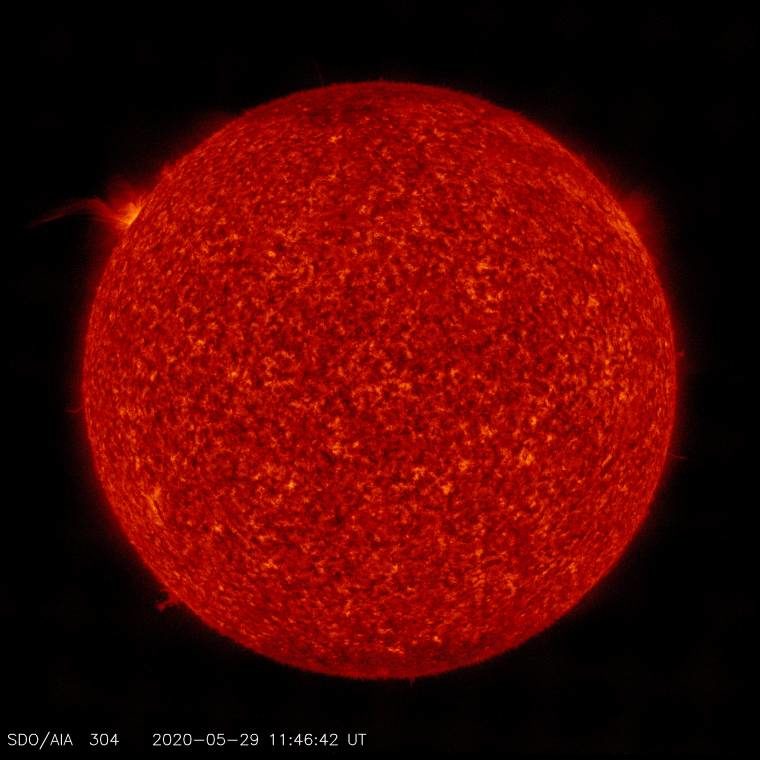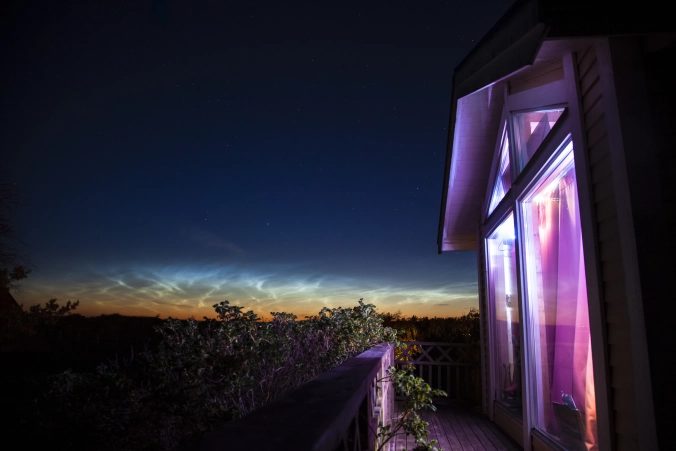
© NASA's Solar Dynamics ObservatoryThe solar flare can be seen at the top left
Today, May 29th, Earth-orbiting satellites detected
an M1-class solar flare (0724 UT) followed by a C9-class flare (1046 UT). Both came from a likely sunspot hiding just behind the sun's northeastern limb. This image from NASA's Solar Dynamics Observatory shows material thrown up by one of the blasts.
These are the strongest solar flares since Oct. 20, 2017--the last time the sun produced an M-class eruption. In fact,
they might be even stronger they they seem. The explosions were partially eclipsed by the edge of the sun, reducing their apparent intensity.
So far the flares have not much affected Earth.
The underlying sunspot is facing away from our planet. However, that could soon change. Solar rotation will bring the 'spot over the limb within the next 24 to 48 hours. Future flares could be geoeffective.
Technically, we don't know for sure that the active region *is* a sunspot. The underlying dark cores have not yet been sighted. Confirmation awaits better viewing geometry--probably tomorrow. Stay tuned! Aurora alerts:
SMS Texts.
Noctilucent Clouds are IntensifyingOn May 17th, NASA's AIM spacecraft detected the first noctilucent clouds (NLCs) of summer. Those
first electric-blue smudges were barely visible. Since then, however, the clouds have rapidly intensified. Recent images from orbit show a growing bank of NLCs pinwheeling just inside the Arctic Circle:
NLCs are Earth's highest clouds. Seeded by meteoroids, they float at the edge of space more than 80 km above the ground. The clouds form when summertime wisps of water vapor rise up to the mesosphere, allowing water to crystallize around specks of meteor smoke. Last summer, they spread as far south as Los Angeles and Las Vegas, setting records for low-latitude sightings.It's early in the 2020 season, so the clouds are still concentrated around the North Pole. Nevertheless, people in Europe are starting to see them. Johny Krahbichler sends this picture taken last night (May 26th) from Ängelholm, Sweden:

© Johny Krahbichler
"These night glowing clouds are pretty common during the summer here in Sweden," says Krahbichler. "But
it's rare that they glow this brightly over such a large area. As soon as I saw them I ran to get my camera. The glow from the clouds ended up matching the glow of my LED strip inside!"
Noctilucent clouds have been likened to a great "geophysical light bulb" because they
turn on abruptly, reaching almost full intensity over a period of ~10 days. By early June, therefore, we can expect the clouds to spread farther south with a significant increase in brightness. The circular rhythm of the pinwheel motion (caused by a 5-day planetary wave) may even allow us to start issuing predictions of latitude ranges where the clouds are most likely to appear.
Cosmic Rays in the AtmosphereWe have developed a new predictive model of aviation radiation. It's called
E-RAD--short for Empirical RADiation model. We are constantly flying radiation sensors onboard airplanes over the US and and around the world, so far collecting more than 22,000 gps-tagged radiation measurements. Using this unique dataset, we can predict the dosage on any flight over the USA with an error no worse than 15%.
E-RAD lets us do something new: Every day we monitor approximately 1400 flights criss-crossing the 10 busiest routes in the continental USA. Typically, this includes more than 80,000 passengers per day. E-RAD calculates the radiation exposure for every single flight.
The Hot Flights Table is a daily summary of these calculations. It shows the 5 charter flights with the highest dose rates; the 5 commercial flights with the highest dose rates; 5 commercial flights with near-average dose rates; and the 5 commercial flights with the lowest dose rates. Passengers typically experience dose rates that are 20 to 70 times higher than natural radiation at sea level.
[See table
here]
To measure radiation on airplanes, we use the same sensors we fly to the stratosphere onboard Earth to Sky Calculus cosmic ray balloons: neutron bubble chambers and X-ray/gamma-ray Geiger tubes sensitive to energies between 10 keV and 20 MeV. These energies span the range of medical X-ray machines and airport security scanners.
SPACE WEATHER BALLOON DATAApproximately once a week, Spaceweather.com and the students of
Earth to Sky Calculus fly space weather balloons to the stratosphere over California. These balloons are equipped with radiation sensors that detect cosmic rays, a surprisingly "down to Earth" form of space weather. Cosmic rays can
seed clouds,
trigger lightning, and
penetrate commercial airplanes. Furthermore, there are studies (
#1,
#2,
#3,
#4) linking cosmic rays with cardiac arrhythmias and sudden cardiac death in the general population.
Our latest measurements show that cosmic rays are intensifying, with an increase of more than 18% since 2015:
The data points in the graph above correspond to the peak of the
Regener-Pfotzer maximum, which lies about 67,000 feet above central California. When cosmic rays crash into Earth's atmosphere, they produce a spray of secondary particles that is most intense at the entrance to the stratosphere. Physicists Eric Reneger and Georg Pfotzer discovered the maximum using balloons in the 1930s and it is
what we are measuring today.
En route to the stratosphere, our sensors also pass through aviation altitudes:
In this plot, dose rates are expessed as multiples of sea level. For instance, we see that boarding a plane that flies at 25,000 feet exposes passengers to dose rates ~10x higher than sea level. At 40,000 feet, the multiplier is closer to 50x.
The radiation sensors onboard our helium balloons detect X-rays and gamma-rays in the energy range 10 keV to 20 MeV.
These energies span the range of medical X-ray machines and airport security scanners.
Why are cosmic rays intensifying? The main reason is the sun. Solar storm clouds such as coronal mass ejections (CMEs) sweep aside cosmic rays when they pass by Earth. During Solar Maximum, CMEs are abundant and cosmic rays are held at bay. Now, however, the solar cycle is swinging toward Solar Minimum, allowing cosmic rays to return. Another reason could be the weakening of Earth's magnetic field, which helps protect us from deep-space radiation.
Comment: See also:
- Planetary wave supercharges extremely rare southern noctilucent clouds event
- Stunning iridescent clouds snapped above skies of Siberia's Belukha mountain
- Breathtaking circumhorizontal arc rainbow captured above Lake Sammamish, Washington
And check out SOTT radio's: